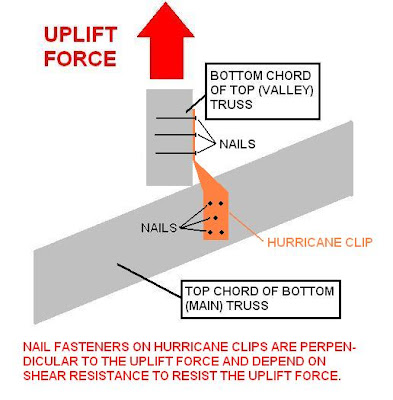Toe nail connections are inappropriate to use in hurricane-prone areas because toe nails are oriented in the same direction as the uplift force. Only the pullout resistence of the nail counteracts the uplift force. Over time, with repeated cyclic loadings, nails can loosen and their pullout resistance becomes reduced. (see figure 2 below)
Hurricane clips are appropriate connectors in a hurricane-prone area because nails in hurricane clips are perpendicular to the uplift force. Nails in hurricane clips depend on the shear resistance of the nails to resist the uplift force. Shear resistance of nails is much greater than their pullout resistance. (see figure 3 below)
Dr. Lawrence Twisdale, PhD, PE, in his report for the State of Florida entitled Development of Loss Relativities for Wind Resistive Features for Residential Structures, Final Report, Version 2.2, March 28, 2002,
(http://www.floridadisaster.org/brm/RCMP/Wind%20Loss/) verifies this analysis.





1 comment:
We built our house 10 years ago. It was before the hurricane strap code, but some builders used them anyway. Mine did not. I begged them to install them. No. Could I do it myself? No.
The reason: other people would walk through my home during construction and want straps on their homes...
OK then!
Post a Comment